#writer spotlight
Text
The Writer's Guide to Authentic Wounds and Fatalities
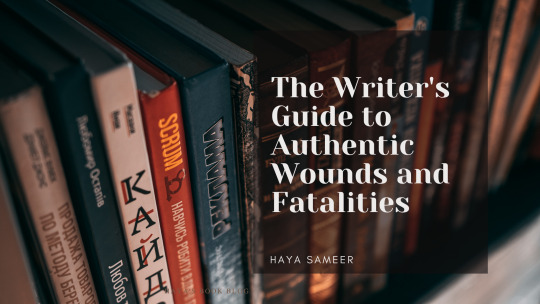
Writing fatal injuries in a story requires a delicate balance between realism and narrative impact. The portrayal of these life-altering events can evoke strong emotions in readers and shape the trajectory of your characters' journeys. In this blog, I will explore the intricacies of depicting fatal injuries in a manner that feels authentic, engaging, and respectful to the gravity of such circumstances. By understanding the nuances of fatal injuries, you will be equipped to craft compelling narratives that resonate with your readers.
Writing Fatal Injuries
When it comes to writing fatal injuries, it is crucial to approach the subject with care and accuracy. Fatal injuries carry immense consequences for your characters and can shape the trajectory of your story. By delving into the intricacies of portraying fatal injuries authentically, you can ensure that the gravity and impact of such events are effectively conveyed to your readers.
Choosing the right injuries for your story
Selecting the appropriate fatal injuries for your narrative involves considering various factors. Ask yourself: What purpose does this injury serve within the story? How does it affect the characters and the overall plot? Conduct thorough research to identify injuries that align with your story's context and resonate with the emotional journey of your characters.
For example, in a historical drama, you may research common fatal injuries during a particular era, such as battlefield injuries, diseases, or accidents prevalent at the time. In a crime thriller, you might explore the portrayal of fatal gunshot wounds or traumatic injuries resulting from violent encounters. By aligning the injuries with the context and themes of your story, you create a more immersive and believable experience for your readers.
Researching the mechanics of fatal injuries
To portray fatal injuries convincingly, it is essential to delve into the mechanics behind them. Understand the specific anatomical structures and systems involved, as well as the forces or mechanisms that can lead to fatal outcomes. Explore medical resources, consult experts if possible, and gather insights into the physiological and psychological implications of such injuries.
For instance, if your character suffers a fatal stab wound, research the anatomy involved, the potential organs affected, and the potential consequences such as internal bleeding or organ failure. By understanding the specific details and implications of the injury, you can describe the physical and emotional toll it takes on the character with greater accuracy and depth.
Depicting the immediate aftermath
When writing about fatal injuries, vividly describe the immediate aftermath to capture the intense emotions and physical realities. Consider the sensory details, the shock and disbelief experienced by characters, and the chaotic environment that often surrounds such events. Balancing realism with the needs of your story, create a scene that immerses readers and evokes empathy.
For example, if a character experiences a fatal car accident, you can depict the chaos at the scene, the character's disorientation, and the reactions of witnesses. Emphasize the sensory details such as the sound of screeching tires or the smell of burning rubber, creating a visceral experience for your readers.
Emotional and dramatic impact on the narrative
The impact of fatal injuries extends beyond the immediate moment. Explore the ripple effects on other characters, relationships, and the overall plot. Delve into the emotional responses, grief, guilt, anger, or determination that arises in the aftermath of loss. Utilize these emotional arcs to deepen character development and drive the narrative forward.
For instance, the loss of a loved one due to a fatal illness might lead to grief and strained relationships among the remaining family members. The emotional journey of a character grappling with guilt and seeking redemption after causing a fatal accident can become a central theme in your story. By delving into these emotional arcs and their consequences, you add depth and resonance to your narrative.
Writing Minor Injuries
While fatal injuries may capture our attention with their dramatic impact, it is equally important to pay attention to the portrayal of minor injuries in your writing. Minor injuries, though less severe, can still significantly affect your characters and contribute to the authenticity of your story. In this section, we will explore the art of depicting minor injuries, ensuring that they are not overlooked or trivialized. By delving into the nuances of minor injuries, you can add depth and realism to your characters' experiences.
Types of minor injuries to consider
When crafting your story, it is essential to consider a range of minor injuries that can occur. These injuries can include cuts, bruises, sprains, minor burns, or even minor fractures. Each type of injury carries its own unique characteristics, associated pain levels, and recovery processes. By understanding these distinctions, you can create accurate and believable depictions that resonate with your readers.
For example, a character who sustains a cut on their hand may experience sharp pain, the sight of blood, and the need for immediate first aid. On the other hand, a character with a sprained ankle may struggle with mobility, experience swelling, and require rest and care for a few days. By paying attention to these specific details, you can enhance the realism of your storytelling.
Conveying pain and discomfort
When writing about minor injuries, it is important to effectively convey the pain and discomfort experienced by your characters. Consider describing the sensation of pain, the throbbing or stinging feeling, and how it affects their daily activities or interactions. Showcasing the emotional impact of pain, such as frustration, irritation, or vulnerability, can deepen the readers' connection to the character's experience.
For instance, if a character suffers from a sprained wrist, you can describe the dull ache that persists, making simple tasks like typing or holding objects challenging. By capturing these small but significant moments, you immerse readers in the character's struggle and create a more realistic portrayal.
Balancing realism with narrative pace
While it is important to depict minor injuries realistically, it is also crucial to strike a balance with the overall pace and momentum of your story. Consider the significance of the injury within the larger context of your narrative. Some injuries may require more detailed attention and impact the plot, while others may serve as background elements. Adjust the level of detail and focus accordingly, ensuring that the portrayal of minor injuries aligns with the narrative's flow.
For example, a small cut on a character's finger may not require an extensive description unless it becomes infected or triggers an unexpected consequence. By aligning the portrayal of minor injuries with their narrative relevance, you maintain a consistent pace while still acknowledging their impact on your characters' lives.
Writing Bloodshed And Realistic Blood Loss
When writing about wounds and injuries, it is essential to consider the amount of blood loss your characters may experience. Realistic portrayal of bloodshed can enhance the authenticity of your scenes and immerse readers in the gravity of the situation. In this section, we will explore the factors influencing blood loss and techniques for accurately depicting it in your writing.
Understanding blood loss and its impact on the body
To authentically portray blood loss, it's crucial to have a basic understanding of how the human body responds to injury. Research the circulatory system and the role of blood in transporting oxygen and nutrients throughout the body. Consider the different types of blood vessels and their potential for bleeding when injured. This knowledge will help you create realistic scenarios and determine the appropriate level of blood loss for specific injuries.
Factors influencing blood loss in different injury scenarios
The amount of blood loss can vary depending on the severity and location of the injury. Factors such as the size of blood vessels, the rate of bleeding, and the body's ability to clot play a significant role. For example, a deep laceration in an artery will result in more substantial blood loss compared to a superficial cut on the skin. Consider these factors when describing injuries and their resulting bloodshed.
Techniques for accurately portraying blood loss in writing
There are several techniques you can use to convey the realistic impact of blood loss in your writing. Describing the color, consistency, and flow of blood can provide vivid imagery. You can also include physical symptoms such as dizziness, weakness, or fainting that may accompany significant blood loss. Additionally, consider the emotional response of your characters and how they react to the sight of blood or their own injuries.
By incorporating these techniques, you can create scenes that evoke a visceral response in readers and enhance the authenticity of your writing.
Bruises: Colors, Progression, and Pain
Bruises are a common result of injuries, and understanding how they form, change in color, and cause discomfort can greatly enhance the realism of your writing. By accurately describing bruises, you can bring depth to your characters' injuries and portray their healing process convincingly.
Understanding the stages and colors of bruises
Bruises go through distinct stages of color as they heal. Initially, they may appear red or purple due to the broken blood vessels beneath the skin. Over time, the color changes to blue, green, yellow, and eventually fades to a brown or yellowish hue. Understanding this color progression can help you accurately describe the age of a bruise and the healing process.
For example, a fresh bruise might be vivid purple, indicating recent trauma, while a fading bruise may have a yellowish tinge, suggesting that healing has begun. By incorporating these color details, you can add realism to your characters' injuries and track the passage of time within your narrative.
Depicting the progression of bruises over time
As bruises heal, they often change in appearance and size. Initially, a bruise may be small and localized, but it can gradually spread and become more extensive. Describing this progression can provide a sense of the healing process and the passage of time within your story.
For instance, a character who sustains a significant blow to the face may develop a bruise that starts as a small spot near the eye but expands to cover a larger area over the next few days. By accurately portraying the progression of bruises, you enhance the authenticity of your characters' injuries and their recovery.
Conveying the pain and sensitivity associated with bruises
Bruises can be painful, sensitive to touch, and affect a character's movement and daily activities. Describing the pain and discomfort experienced by your characters can create empathy and immerse readers in their physical ordeals.
Consider conveying the tenderness of a bruise when pressure is applied, the throbbing sensation, or the limitation of movement due to the pain.
Remember The Side Effects
Injuries, whether minor or severe, often come with a range of side effects that can significantly impact your characters' lives. These side effects can extend beyond the physical realm and encompass emotional, psychological, and social aspects.
Physical side effects
Injuries can have profound physical side effects that go beyond the immediate pain and discomfort. Consider the potential consequences such as limited mobility, impaired coordination, chronic pain, or the need for assistive devices like crutches or braces. Describing these physical side effects can add depth to your characters' struggles and provide a realistic portrayal of their healing journey.
For example, a character who sustains a leg injury may experience difficulty walking, require physical therapy, or have long-term complications that affect their day-to-day activities. By addressing these physical side effects, you create a more nuanced depiction of the aftermath of injuries.
Emotional and psychological side effects
Injuries can have a profound emotional and psychological impact on characters. They may experience fear, anxiety, trauma, or a loss of confidence. Consider how the injury affects their self-image, relationships, or mental well-being. Explore the emotional journey your characters undergo as they navigate the aftermath of their injuries.
For instance, a character who survives a near-fatal accident may develop post-traumatic stress disorder (PTSD) and struggle with recurring nightmares or panic attacks. By incorporating these emotional and psychological side effects, you can deepen the complexity of your characters and their responses to traumatic experiences.
Social implications and changes
Injuries can also lead to significant social changes for your characters. They may face challenges in their personal relationships, encounter stigma or discrimination, or experience changes in their roles or identities. Explore how the injury affects their interactions with others and their sense of belonging in the world.
For example, a character who sustains a facial injury may encounter judgment or stares from others, leading to self-consciousness or isolation. By addressing the social implications and changes resulting from injuries, you can create multi-dimensional characters and explore the impact of their injuries on their social dynamics.
By incorporating these various side effects into your writing, you bring depth and authenticity to your characters' experiences and showcase the wide-ranging impact of injuries.
Conclusion
Writing authentic wounds and fatalities requires attention to detail and a deep understanding of the physical, emotional, and psychological aspects involved. By following the guidelines and exploring the subheadings discussed in this guide, you can create compelling and realistic portrayals of injuries in your writing.
Remember to conduct thorough research on the specific injuries you want to depict, understanding their mechanics, symptoms, and potential outcomes. Consider the immediate and long-term effects on your characters, both physically and emotionally. Incorporate sensory details to immerse readers in the experience, describing the pain, bloodshed, colors of bruises, and the progression of healing.
Additionally, don't forget to address the side effects that injuries can have on your characters' lives. Explore the physical limitations, emotional struggles, and social implications that arise from their injuries. By delving into these aspects, you can create well-rounded characters and compelling narratives that resonate with readers.
I hope this blog on forging epic battles will help you in your writing journey. Be sure to comment any tips of your own to help your fellow authors prosper, and follow my blog for new blog updates every Monday and Thursday.
Looking For More Writing Tips And Tricks?
Are you an author looking for writing tips and tricks to better your manuscript? Or do you want to learn about how to get a literary agent, get published and properly market your book? Consider checking out the rest of Haya’s book blog where I post writing and publishing tips for authors every Monday and Thursday! And don’t forget to head over to my TikTok and Instagram profiles @hayatheauthor to learn more about my WIP and writing journey!
#hayatheauthor#haya's book blog#haya sameer#haya blogs#writers on tumblr#writer community#writer tools#writer blog#writer stuff#writer wednesday#writer tips#creative writing#writers of tumblr#writerscommunity#writeblr#writing community#writer spotlight#writer things#writing prompt#writing tools#writing stuff#writing#writing life#writing inspo#writing help#writing advice#writing inspiration#writing ideas#writing things#writing tip
4K notes
·
View notes
Text

Writer Spotlight: Jamie Beck
Jamie Beck is a photographer residing in Provence, France. Her Tumblr blog, From Me To You, became immensely successful shortly after launching in 2009. Soon after, Jamie, along with her partner Kevin Burg, pioneered the use of Cinemagraphs in creative storytelling for brands. Since then, she has produced marketing and advertising campaigns for companies like Google, Samsung, Netflix, Disney, Microsoft, Nike, Volvo, and MTV, and was included in Adweek Magazine’s “Creative 100” among the industry’s top Visual Artists. In 2022, she released her first book, An American in Provence, which became a NYT Bestseller and Amazon #1 book in multiple categories, and featured in publications such as Vogue, goop, Who What Wear, and Forbes. Flowers of Provence is Jamie’s second book.
Can you tell us about how The Flowers of Provence came to be?
I refer to Provence often as ‘The Garden of Eden’ for her harmonious seasons that bring an ever-changing floral bounty through the landscape. My greatest joy in life is telling her story of flowers through photography so that we may all enjoy them, their beauty, their symbolism, and their contribution to the harmony of this land just a bit longer.

(Photograph: Jamie Beck)
How do your photography and writing work together? Do you write as part of your practice?
I constantly write small notations, which usually occur when I am alone in nature with the intention of creating a photograph or in my studio working alone on a still life. I write as I think in my head, so I have made it a very strict practice that when a thought or idea comes up, I stop and quickly write the text in the notes app on my phone or in a pocket journal I keep with me most of the time. If I don’t stop and write it down at that moment, I find it is gone forever. It is also the same practice for shooting flowers, especially in a place as seasonal as Provence. If I see something, I must capture it right away because it could be gone tomorrow.

(Photograph: Jamie Beck)
You got your start in commercial photography. What’s something you learned in those fields that has served you well in your current creative direction?
I think my understanding of bridging art and commerce came from my commercial photography background. I can make beautiful photographs of flowers all day long, but how to make a living off your art is a completely different skill that I am fortunate enough to have learned by working with so many different creative brands and products in the past.

(Photograph: Jamie Beck)
Do you remember your first photograph?
Absolutely! I was 13 years old. My mother gave me her old Pentax 35mm film camera to play with. When I looked through the viewfinder, it was as if the imaginary world in my head could finally come to life! I gave my best friend a makeover, put her in an evening gown in the backyard of my parents’ house in Texas, and made my first photograph, which I thought was so glamorous! So Vogue!
You situate your photographic work with an introduction that charts the seasons in Provence through flowers. Are there any authors from the fields of nature writing and writing place that inspire you?
I absolutely adore Monty Don! His writing, his shoes, and his ease with nature and flowers—that’s a world in which I want to live. I also love Floret Flowers, especially on social media, as a way to learn the science behind flowers and how to grow them.
How did you decide on the order of the images within The Flowers of Provence?
Something I didn’t anticipate with a book deal is that I would actually be the one doing the layouts! I assumed I would hand over a folder of images, and an art director would decide the order. At first, it was overwhelming to sort through it all because the work is so personal, and I’m so visual. But in the end, it had to be me. It had to be my story and flow to be truly authentic. I tried to move through the seasons and colors of the landscape in a harmonious way that felt a bit magical, just as discovering Provence has felt to me.
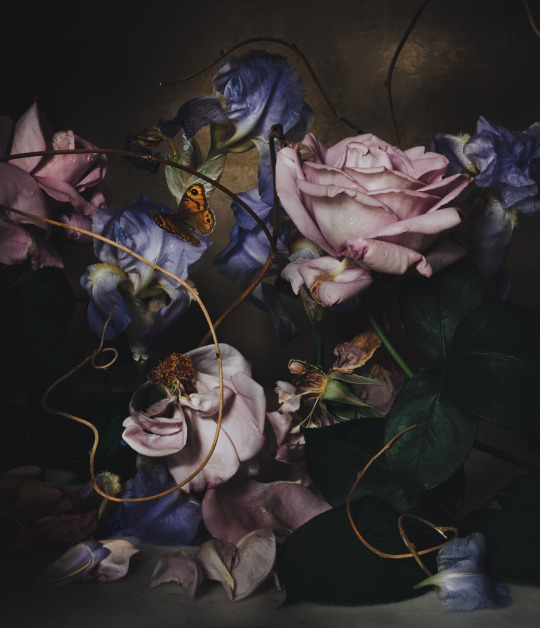
(Photograph: Jamie Beck)
How do you practice self-care when juggling work and life commitments alongside the creative process?
The creative process is typically a result that comes out of taking time for self-care. I get some of my best ideas for photographic projects or writing when I am in a bath or shower or go for a long (and restorative) walk in nature. Doing things for myself, such as how I dress or do my hair and makeup, is another form of creative expression that is satisfying.
What’s a place or motif you’d like to photograph that you haven’t had a chance to yet?
I am really interested in discovering more formal gardens in France. I like the idea of garden portraiture, trying to really capture the essence and spirit of places where man and nature intertwine.
Which artists do you return to for inspiration?
I’m absolutely obsessed with Édouard Manet—his color pallet and subject matter.
What are three things you can’t live without as an artist?
My camera, the French light, and flowers, of course.
What’s your favorite flower to photograph, and why?
I love roses. They remind me of my grandmother, who always grew roses and was my first teacher of nature. The perfume of roses and the vast variety of colors, names, and styles all make me totally crazy. I just love them. They simply bring me joy the same way seeing a rainbow in the sky does.

(Photograph: Jamie Beck)
#writer spotlight#jamie beck#the flowers of provence#art#photography#flowers#cottagecore#aesthetics#naturecore#flowercore#still life#nature aesthetic#artist#artists on tumblr#fine art photography#long post#travel#France#Provence#original photographers#photographers on tumblr
1K notes
·
View notes
Note
the things we shouldn't do / lukloé

The response for this prompt comes to us from @chai-ki!
---
There was no way this was possible, he shouldn’t, but there was no recalling a note once it had been played. He was plummeting straight towards the greatest of betrayals and yet he couldn’t help himself; like a moth drawn to the blinding light of the sun, she lured him in without ever having uttered a single word.
Jules had grown confident over the last few years, but he knew (yes, he knew) she still had fears based on the past. How on earth could he do this to her? Would she ever forgive him? Sure, she said she’d let the past go but it was easy to see how affected she’d been by it all. Small comments would cause the light in her eyes to dim, her smile to fall.
He shouldn’t be in love with the one who caused his sister pain.
But he was.
Chloe’s inner melody enveloped him, staking its claim in his mind, refusing to budge. The first time he’d seen her after she came back to Paris he’d found himself entranced as she stood across the street from him, talking with her sister. Despite the confident way she stood, the arrogant aura she used to hold was nowhere to be seen. Chloe was beautiful. The melancholy notes that flowed from within spoke of loss and a longing for someone to love her without condition. There was an undertone of resilience, attesting to a woman who had made her way on her own.
The ballad of Chloe Bourgeois was captivating, filling his soul like never before.
When Luka had been caught staring, she offered him a small smile accompanied by a slight wave before turning and heading into the hotel.
Chloe had haunted his dreams since.
Slowly, she had integrated again with his main group of friends, proving herself a changed soul. She never conversed with him but he wasn’t sure if that was her own choice or the way he tried (and failed) to keep himself distant.
Lack of conversation did little, if anything, to keep them from growing closer. They stole glances at one another more often than not, the intensity enough to leave him reeling every time. Gentle touches ignited something within; Chloe’s shoulder brushing against his arm as she walked by, Luka’s fingers reaching out and tracing the back of her hand as he would circle back.
Tonight was no different, they’d passed each other more times than he could count and Luka found himself set ablaze, completely unable to extinguish the desire within.
Juleka’s laughter echoed in his mind and he was again reminded of why this was a bad idea, why he was wrong for wanting it. As he held Chloe’s cerulean stare from across the room, he knew he couldn’t deny it any longer.
Head held high, Luka crossed the floor, never once looking away; refusing to falter. Chloe remained firmly in place as he approached, watching intently. Heart pounding with each of his final steps, Luka cupped her cheeks and crashed their lips together without hesitation. Chloe returned his passion with fervor, tangling her fingers in his hair as she pulled him closer.
Luka slid his arms around her sealing their fate as he continued to deepen their kiss, the harmony they created heavily intoxicating. Around them their friends and family cheered, the cadence of a sonata to concerto.
In life there are things you shouldn’t do. Loving Chloe was not one of those things.
---
Want to participate in this month's event? Check out the rules, and send us a prompt!
#writer spotlight#chai-ki#ml writers guild#march event 2024#the fic i might write#ask game#miraculous ladybug#ml fic#lukloe
25 notes
·
View notes
Text
Meet our... last but not least, writers!


Check them out on their social media,
and welcome them to the zine!
@radio-show
@j0eyj0rdis0n
30 notes
·
View notes
Text
The New York Bell Company
Contributor applications have closed and our contributors are hard at work on their submissions, so what better time to introduce them! Without further ado, here are the incredible writers working on the zine with us. Check out our artists here, and stay tuned for individual spotlights coming soon!


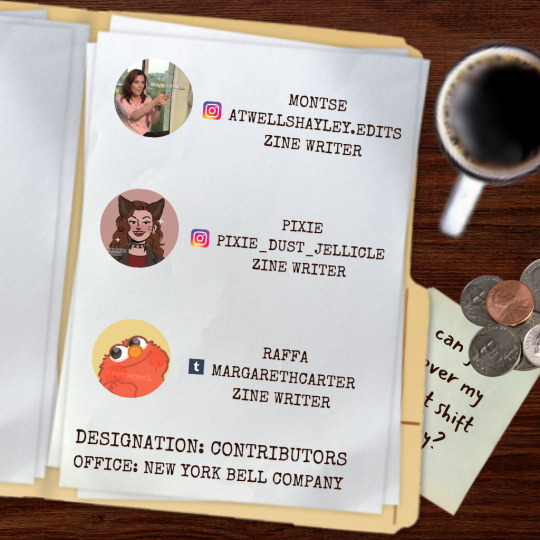

@captainsophiestark @redvanillabee @dandelion-writes @margarethcarter @spaceagesparkledust
#agent carter zine#agent carter#peggy carter#daniel sousa#jack thompson#angie martinelli#dottie underwood#edwin jarvis#fan zine#howard stark#marvel#marvel zine#writers#writer spotlight#zine writer spotlight
14 notes
·
View notes
Text
🎧 CONTRIBUTOR SPOTLIGHT: Aevallare

Please give a warm welcome to the incredible Aevallare (@aevallare)! What fantastic writing is she busy cooking up? We're so excited to have her talents, both with prose & on the rift.
⚡️‧₊˚⊹⁺₊ ROLE: Writer
💽 ♫⋆。♪ FAV ARTISTS: True Damage. Jayce!
#league of legends zine#lol musicverse#fanzine#lol zine#k/da#evelynn#ahri#contributor spotlight#writer spotlight
14 notes
·
View notes
Text
Writer Spotlight: Commie
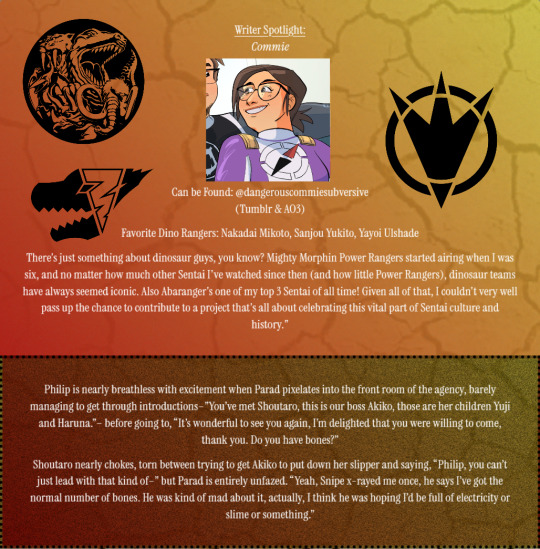
Check out their work over at her Tumblr and AO3! With their eclectic collection of tokusatsu work, we're so excited to see what they bring to the table! Keep an eye on us to meet the other contributors in the weeks to come!
#writer spotlight#contributor spotlight#super sentai#fanzine#zyuden sentai kyoryuger#kyoryu sentai zyuranger#kishiryu sentai ryusoulger#bakuryuu sentai abaranger#dino force brave
13 notes
·
View notes
Text


✨ Don't leave us so soon, here will come our Writers and Merch Artists! ✨
#kingdom hearts#kingdom hearts dark road#kingdom hearts fanzine#kh:dr#contributors lineup#writer spotlight#merch artist spotlight
44 notes
·
View notes
Text
ENEMY WITHIN SPOTLIGHT
One of our fantastic writers @no-shxme!
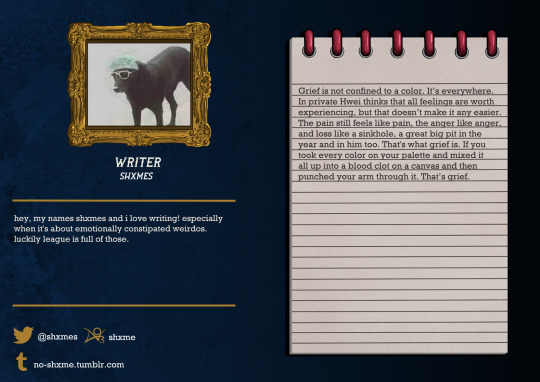
#league of legends zine#league of legends#league zine#fanzine#fanzines#lol zine#zine spotlight#writer spotlight
8 notes
·
View notes
Text
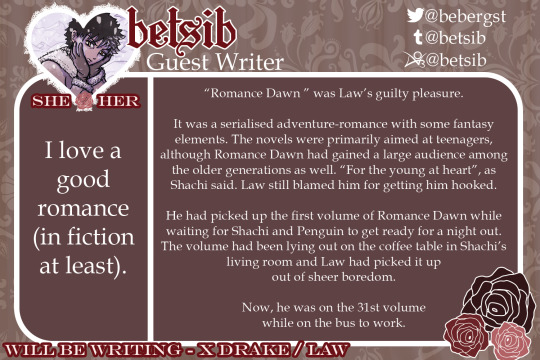
🌹Guest Writer Spotlight🌹
Welcome our first guest writer @betsib! She loves a good romance and will be writing some for X Drake and Law!
#anime#anime zine#anthology#anthology zine#fan zine#fanfic#literature#manga#one piece#one piece zine#guest contributor#zine contributor#contributor spotlight#writer spotlight
7 notes
·
View notes
Text

✒️Writer Spotlight: Ghost✒️
"hi, i'm an average fic writer who spends more time thinking about writing than actually writing :')"
💙One word to describe Bachisagi: "soulmates"
💛Why do you love Bachisagi?
"i love their unhinged take on the classic friends to lovers trope"
⚽You can find Ghost on Twitter and Ao3.
#blue lock#ブルーロック#blue lock zine#isagi yoichi#bachira meguru#bachisagi#isabachi#bachira x isagi#monster zine#contributor spotlight#writer spotlight
10 notes
·
View notes
Text
Everything You Need To Know About Writing Gunshot Wounds
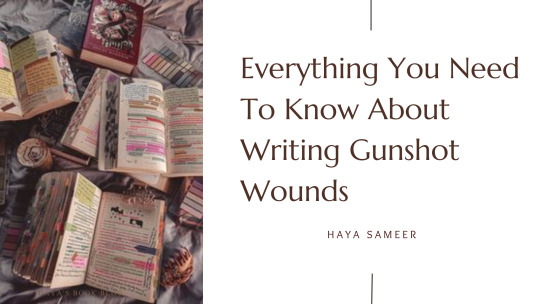
Welcome to the latest installment in my ongoing series on crafting realistic wounds in fiction! After covering stab wounds and burns, it's time to explore the next wound category frequently explored in fiction—gunshot wounds.
Gunshot wounds are a recurring motif in the realm of storytelling. They're something you can easily come across in every genre, however, authors often poorly portray gunshot wounds due to lack of proper research. I understand finding the right resources to aid with your writing can be hard, so here's my comprehensive guide on how to write gunshot wounds.
How To Categorise Gunshot Wounds
There are certain factors you need to consider before writing a gunshot wound. These details are instrumental in crafting a vivid and plausible narrative while avoiding plot holes. The first and most important one is identifying the type of firearm used to inflict the wound.
Picking The Right Firearm
Selecting the appropriate firearm to inflict a gunshot wound is a pivotal decision. It's not just about choosing any gun; it's about picking the right one to align with your desired outcome and the narrative's overall impact. Here's a quick guide on how to pick the right firearm.
The Impact of Firearm Selection
The firearm you choose can significantly influence the severity and appearance of the gunshot wound. Whether your goal is a graphic, gory injury or a precise, long-range shot, the choice of firearm plays a crucial role. Here are some guns you to consider:
Handguns: These are versatile and commonly used in close-quarters combat. They can result in gruesome, close-contact wounds with a higher potential for damage due to their stopping power.
Shotguns: Shotguns disperse shot pellets upon firing, making them suitable for creating a broader pattern of injuries. If you aim to depict a devastating, close-range gunshot wound, shotguns can be a fitting choice.
Rifles: Rifles are known for their accuracy at longer distances. When you need a precise, long-range shot, rifles are the go-to option. They tend to produce a cleaner wound channel, especially when used for a targeted, well-planned injury.
Choosing the Right Firearm for Your Narrative
The type of firearm you select should align with your story's objectives. If you intend to evoke visceral, gory reactions, opt for handguns or shotguns used in close proximity. On the other hand, if precision and long-range engagement are key, rifles can achieve your desired outcome.
Keep in mind that firearm selection can affect the wound's damage, trajectory, and overall portrayal in your narrative.
Categorising The Wound
Once you've identified the type of firearm, you need to establish what type of wound your character will incur.
In order to bring your character's injuries to life, it's important to first identify what you're dealing with. You can do this by categorising the injury based on several factors. For gunshot wounds, this includes the type of firearm used, the bullet's trajectory, and the specific areas of the body affected.
You can categorise your character's gunshot would into seven main categories, here's a quick breakdown of what these categories look like and the level of severity associated with them:
Penetrating Gunshot Wounds: These wounds occur when a bullet enters the body but doesn't exit. The bullet remains inside the body, causing damage along its path.
Perforating Gunshot Wounds: In this case, the bullet enters the body and exits on the opposite side. This type of wound can have a different set of implications due to the bullet's trajectory.
Ricochet Gunshot Wounds: Ricochet wounds happen when the bullet bounces off a surface before hitting the character. The nature of the surface can influence the severity of the wound.
Through-and-Through Gunshot Wounds: As the name suggests, these wounds occur when the bullet enters one side of the body and exits through the other. The trajectory can greatly affect the injury's severity.
Close-Contact Gunshot Wounds: These wounds result from the firearm being fired at extremely close range. The proximity of the gun to the body can lead to unique wound patterns and burn injuries.
Shotgun Wounds: Shotgun wounds differ from those caused by handguns or rifles. The shot pellets disperse upon firing, leading to a broader pattern of injury.
Long-Range Gunshot Wounds: When a character is shot from a considerable distance, the wound might appear different due to factors like bullet tumbling and loss of velocity.
The Anatomy of a Gunshot Wound
To create a vivid portrayal of a gunshot wound, writers need to grasp not only the external appearance but also the internal effects it has on the body. A well-executed description captures both the physical trauma and the emotional turmoil experienced by the character. Here are some symptoms you should take into consideration.
1. External Appearance and Bleeding:
Wound Size: The size of a gunshot wound can vary significantly based on the type of firearm and bullet used. Smaller calibers may leave entry and exit wounds that are relatively small, while larger bullets or high-velocity rounds can create much larger wounds. Be specific about the size, which can help readers visualize the injury.
Blood Loss: Gunshot wounds typically result in bleeding. The severity of bleeding depends on factors like the wound's location, the size of the blood vessels damaged, and the bullet's trajectory. Mention the amount of blood, but avoid excessive gore unless it serves a specific purpose in your narrative.
Coughing Up Blood: If the gunshot wound affects the chest or lung area, characters may cough up blood. This symptom often signifies a more critical injury and can add drama to your story.
2. Internal Damage and Symptoms:
Pain: Gunshot wounds are painful, and the character should express this pain through their actions, dialogue, and internal thoughts. Describe the sharp, burning, or throbbing sensations as they resonate through the character's body.
Shock: Depending on the severity of the wound, shock can set in. The character may appear pale, sweaty, and disoriented. This state of shock can impact their actions and decisions.
Loss of Function: A gunshot wound may impair the use of the injured body part. Describe any loss of function, such as the inability to move a limb or use it effectively.
Fainting: In extreme cases, characters may faint due to the pain, blood loss, or shock. Be sure to contextualize this within the narrative, as fainting can have significant consequences for the character.
By diving into the details of a gunshot wound's anatomy, you can craft a compelling and realistic portrayal that draws readers into the character's harrowing experience. I haven't exactly covered every symptom out there, but these are the major ones you should take into account when writing.
Medical Assessment and Treatment
Once you've established your gunshot wound, it's now time to focus on the aftermath. One of the main factors to consider is the medical process that follows. If your character is supposed to die from the gunshot then you could probably skip this section, but if they're alive here are things you need to consider.
1. Initial Assessment:
Scene Safety: In a real-life scenario, safety is paramount. First responders will ensure the scene is secure before approaching the injured person. Consider factors like the presence of firearms, potential threats, and the safety of medical personnel.
ABCs of Assessment: Medical professionals follow the ABCs—Airway, Breathing, and Circulation. Writers can reflect this in their storytelling by highlighting the character's ability to breathe, cough, or speak after being shot.
Vital Signs: Mentioning vital signs like heart rate, blood pressure, and oxygen saturation can help convey the character's condition and the urgency of their medical treatment.
2. Trauma Assessment:
Focused Assessment: Medical personnel perform a thorough examination to identify the gunshot wound's location, entry and exit points, and any associated injuries. This assessment informs their treatment plan.
Imaging: Depending on the complexity of the injury, X-rays or other imaging may be required to visualize the bullet's trajectory and any potential damage to internal organs or bones.
3. Treatment:
Bleeding Control: Stopping the bleeding is a top priority. This may involve applying pressure, packing the wound, or even tourniquet application in extreme cases.
Wound Care: Depending on the wound's severity, cleaning and suturing may be required. The character's response to this procedure can add an element of realism to your narrative.
Pain Management: Gunshot wounds are excruciatingly painful, and medical personnel will often administer pain relief or anesthesia during treatment.
Monitoring and Observation: Patients with gunshot wounds require careful observation and monitoring for signs of infection, complications, or changes in their condition.
By accurately portraying the medical assessment and treatment of gunshot wounds, you not only enhance the authenticity of your writing but also depict the physical and emotional toll such injuries can take on your characters. This attention to detail helps your readers connect more deeply with the story.
The Psychological Impact
Gunshot wounds don't just inflict physical harm; they also leave lasting emotional and psychological scars. It is important to note that the extent of the psychological impact on your characters will heavily rely on various factors.
For example, you need to consider whether or not this injury is something normal for them. Do they work as a spy, assassin, or other such roles that would mandate such dangerous injuries? You also need to consider who shot them. Does this wound come with emotional damage as well? Think of Aaron Warner’s reaction to Juliet shooting him.
If you’re sure your character will have some extent of a psychological impact, here are some factors you should consider.
1. Shock and Denial:
Immediate Response: Characters who have been shot may initially experience shock and denial. This can manifest as disbelief, emotional numbness, or a surreal sense of detachment from the situation.
Physical Symptoms: Shock can lead to physical symptoms like trembling, chills, or even fainting. Incorporating these details can make the character's reaction more genuine.
2. Fear and Anxiety:
Survivor's Guilt: Characters may grapple with survivor's guilt if they are the only ones to emerge unscathed in a violent encounter.
Anxiety: The threat of recurrence or the fear of returning to the location where the shooting occurred can trigger anxiety and panic attacks.
3. Post-Traumatic Stress Disorder (PTSD):
Flashbacks and Nightmares: Characters who have survived a gunshot wound may experience recurring flashbacks and nightmares, vividly reliving the traumatic event.
Hypervigilance: PTSD can lead to hypervigilance, where characters are constantly on edge, expecting danger at every turn.
4. Depression and Isolation:
Emotional Withdrawal: Characters may withdraw from social interactions, experiencing feelings of isolation and sadness.
Emotional Numbness: Some may describe feeling emotionally numb, unable to experience joy or pleasure.
5. Recovery and Resilience:
Therapeutic Support: In your storytelling, consider how characters seek therapy or counseling to cope with their emotional scars. Therapy can be a path toward recovery and resilience.
By addressing the psychological impact of gunshot wounds on your characters, you create more layered and relatable individuals within your narrative. This depth allows readers to connect with the characters on a profound emotional level.
I hope this blog on Everything You Need To Know About Writing Gunshot Wounds will help you in your writing journey. Be sure to comment any tips of your own to help your fellow authors prosper, and follow my blog for new blog updates every Monday and Thursday.
Looking For More Writing Tips And Tricks?
Are you an author looking for writing tips and tricks to better your manuscript? Or do you want to learn about how to get a literary agent, get published and properly market your book? Consider checking out the rest of Haya’s book blog where I post writing and publishing tips for authors every Monday and Thursday! And don’t forget to head over to my TikTok and Instagram profiles @hayatheauthor to learn more about my WIP and writing journey!
#hayatheauthor#haya's book blog#haya sameer#haya blogs#writers on tumblr#writer community#writer tools#writer blog#writer stuff#writer wednesday#writer tips#creative writing#writers of tumblr#writerscommunity#writeblr#writing community#writer spotlight#writer things#writing prompt#writing tools#writing stuff#writing#writing life#writing inspo#writing help#writing advice#writing inspiration#writing ideas#writing things#writing tip
2K notes
·
View notes
Text

Writer Spotlight: Tamsyn Muir
Tamsyn Muir probably doesn’t need a lot of introduction here on Tumblr, but for those who aren’t yet familiar with her work: Tamsyn Muir is the bestselling author of the Locked Tomb Series. Her fiction has won the Locus and Crawford awards. It has been nominated for the Hugo Award, the Nebula Award, the Shirley Jackson Award, the World Fantasy Award, the Dragon Award, and the Eugie Foster Memorial Award. A Kiwi, she has spent most of her life in Howick, New Zealand, with time living in Waiuku and central Wellington. She currently lives and works in Oxford, in the United Kingdom.
We asked Tamsyn some questions about Nona the Ninth, the next installment of the Locked Tomb series, which comes out on September 13. (Mild spoilers ahead. You have been warned!)
Can you tell us about Nona the Ninth? How would you contextualize it alongside the previous Gideon the Ninth and Harrow the Ninth?
The Locked Tomb has always followed a concrete set of rules about whose point of view we’re in—there’s a priority list and a hard if-and-else-if set of codes about who is telling the tale. The priority character is always Gideon Nav herself, but after Gideon the Ninth, in many ways, she gets knocked out of the ring.
Nona is the next rule on the priority list—the next storyteller. Except there are also a bunch of other storytellers popping up in the priority list as she lets her guard down. That’s kind of one curtain I wanted to pull back on The Locked Tomb as a whole. Who’s telling this story? What is the truth as someone else understands it? Which is why, where the last two books have been told very much from the perspectives of the Nine Houses, we’re finally in a setting where the Houses have pulled back, and the truth told is completely different.
You have a knack for approaching the next part of the story from a completely different vantage point, which is deliciously frustrating for the reader. Why do you think this works so well (when really, it sort of shouldn’t)?
Oh, but it does, and it’s been proved to work—just play an RPG! One thing I passionately loved in Final Fantasy IX, my very favourite Final Fantasy at the end of the day, is that one moment you’re with the thief-turned-thespian Zidane and a wonderfully dashing attempt to kidnap a princess in the middle of a theater performance—then you’re with…some very bizarre kid called Vivi…who has lost his ticket and is getting negged by a horrifying rat child. You’re given a completely different lens on a completely different situation in what’s basically a completely different genre. In the same game! There’s a risk of getting too comfortable in someone’s truth—you might want to settle down in a character whom you have learned to understand. But then you have to practice a very radical empathy in settling down in Nona, who just absolutely does not give a shit about swords or empire and, at her worst, can be quite an irritating, materialistic babe in the woods who is WAY too into dogs. Of course it’s alienating. If the experience of being in Gideon’s head was the same as being in Harrow’s as being in Nona’s, there wouldn’t be any point. If different vantage points didn’t work, A Song of Ice and Fire would never have gotten off the ground. Hell, neither would The Iliad. I just sit longer with my vantage point.
After writing foul-mouthed and horny Gideon and acerbic, memory-challenged, and also horny Harrow, how did you approach writing Nona’s character, and what did you enjoy most about the process?
Harrow would hate that you described her as horny. Gideon would be fine with being described as horny. Nona would love to sit you down and talk about all the things that make her horny, at the end of which you are 50% worried that she doesn’t honestly understand ‘horny,’ and 50% worried that she DOES understand ‘horny.’
Nona is my character who doesn’t give a fuck. Gideon and Harrow both give too many. It was fun to write a character who sincerely seeks out love as she understands it, who has a large collection of friends and interests, and has no ambition. And yet what I really enjoyed is that Nona is easily also the most terrifying POV character of the series.
We meet some old friends in a new place in Nona. What aspect of the familiar characters meeting the unfamiliar world was the most fun to write?
Honestly, the fact that they’re in such a different milieu was fun enough. One is a woman completely out of time, trying to find something to live for; two are dyed-in-the-wool Housers forced to re-examine values they’ve always taken for granted and what the next part of life after death is going to look like for them. All three are fish out of water. And then there’s actually the reader meeting the familiar after two long books about the unfamiliar, and all the ways I hope that’s entirely weird and recontextualizing. And then, for Nona, what’s familiar to us is entirely unfamiliar to her. Writing Nona was like one long experiment with jamais vu.
When Lyctorhood goes south or gets experimented with, we get someone’s mind in someone else’s body. What is it that drew you to writing this Cartesian mechanism into the universe of the Nine Houses?
Oh my God, please do not spring words like Cartesian on me, I have not had lunch yet.
My understanding is that Descartes thought mind and matter were two completely different things and then got stuck trying to explain why they don’t feel like two completely different things. So if someone kicks you in the goolies and your mind forms the thought ‘yowch, my goolies,’ how is that mind-matter gulf being bridged? Minds in The Locked Tomb lose to matter nine times out of ten. (This is linked, not coincidentally, to my experience of psychosis.) Gideon’s mind is constantly in danger of being sucked away into the storm drain of Harrow’s matter. Revenants are minds that have temporarily anchored themselves to foreign matter, but over time the matter exerts itself, and the mind starts to fall apart. So when you get a mind that’s big enough not only to resist the matter it’s attached to but actually to start burning that matter up…well, what kind of mind could possibly be so powerful?? (Significant looks at camera.)
You’ve previously headcanoned the often affectionately named “Jod” as Taika Waititi (which offers up the potential for some delightful space-god-gay-pirate crossover fic, thank you). Do you have any casting headcanons for the other characters?
I have recently admitted to loving Erana James as Harrow, except I don’t think Harrowhark is quite that good-looking.
By the way, I wish I had come up with Jod. Whoever did, well done you.
We know you’re not allowed to read fanfic for legal reasons, but who would you find intriguing as a ship proposition and why?
I find all ships intriguing. I’ve spent too long in these mines. No ship is too problematic or cracky for me. My only hope is to out-fandom fandom by presenting them with ships more problematic and crack-filled than they do (I will not; fandom always wins). In these tiresome days where ship wars have been taking on airs, as is my understanding, of virtue versus sin (I don’t even know what Bakudeku is and yet I feel sorry for anyone who ships it; I didn’t ship Reylo because it wasn’t messed-up enough and feel the same), I hope the Locked Tomb fandom is just accepting that all shipping is batshit and every ship is just as bad as the next. Gideon x Harrow is just as bad as Teacher x Crux is as bad as Hot Sauce x Cytherea the First is as bad as Camilla x Juno Zeta is as bad as Silas x Every Asht Brother (actually, I wrote the Asht brothers in an unrelated piece that’ll never see the light of day and imo they’ve suffered enough, but).
I was in the Kingdom Hearts fandom briefly. We shipped people with Goofy. Actually, let’s go with that. Naberius Tern x Goofy. On second thought, please don’t go with that. Goofy had a happy marriage and would know better.
This question has sparked some debate among the editorial team here because we absolutely can’t agree on one. Do you have a favorite character?
Yes. As of twenty seconds ago, it’s Naberius because I can’t enthuse enough over how he and Goofy’s relationship would break down because Babs spends so much money on silk pillowcases to avoid hair frizz. He only needs two, max, but has twenty. I hope Goofy goes on longer and longer adventures with Sora and Donald to try to ignore how his love life is breaking down over Naberius leaving the wedding they were just attending because he saw some other dude wearing the same shirt. Leave him, Goofy!!!
If Nona had a Tumblr, what would it be called, and what would she post?
It would just be a single text post with ‘hi,’ and she didn’t even write it. She dictated to Camilla, then ran out of ideas. Her profile just says ‘nona,’ and it’s a default layout. Nona just wouldn’t see the point of Tumblr, even if you told her there were pictures of dogs: why would you want to see a picture of a dog when you could be near a dog in real life? (I told you Nona was scary.)
Which house would you belong to, and do you see yourself more as an adept or cavalier?
I belong to No House. I’ve never been able to belong to a House. I’ve never been able to sort myself into anything really; I’ve tried, and nothing sticks. I can’t be an adept or a cavalier either, I’m just sitting in the corner glumly eating hot dogs. I guess I’m Hot Dog House.
The Locked Tomb fanart is strong here on Tumblr. Do you have a favorite piece you’ve seen recently?
Every piece I have seen recently is my most favorite piece! I was just in Spain for the Celsius convention, and the most intensely wonderful thing was that I came away with fan art that the fans have done. I don’t know what they’re feeding them there in Spain, but pretty much every fan was just nonchalantly like, ‘I drew this,’ and presented me with the goddamn Sistine Chapel. Someone had, while they were waiting in a queue, just filled a sketchbook with the most incredible work on the fly. Special shout-out to a marvelous flipbook I got where Harrow and Gideon are ducks.
The plan was for Alecto the Ninth to be the third and last book. Here we are with Nona the Ninth and Alecto still set to appear (we are not complaining). How has that process been?
AWFUL!!!!
It took me a long time to let go of the fact that it wasn’t going to be a trilogy; it was four books. I want the story to be done now! For one thing, because I’m really excited about the ending, and for another thing, the longer this goes on, the more of a terrible gremlin I become. The Locked Tomb is very special to me, but also I have five million other stories to write and only so long in a lifetime. I’ve been with this world since 2018, and I am wildly excited to get to all the other places. My editor and I will, I think, shed a sentimental tear on the final page, but also, you haven’t even met Teresa Santos yet, who has kept every gun she has ever loved.
What kind of writer are you? A plotter? A pantser? Do you have any morning rituals that set you up for a day of writing?
Plotter. I envy pantsers and gardeners. This is why Nona being unexpected got to me so much. I don’t actually have any rituals or exercises or anything—it’s important for me to have a specific writing space and a good breakfast. But every book is different. Like, what helped with Harrow was breaking every so often to die in Donkey Kong Country.
Do you have any writing or publishing or life advice for any budding queer sci-fi writers reading this?
I see so many writers—and this may also have something to do with being a queer writer—giving themselves SUCH a goddamned hard time. If I could give any advice to them, it would be to stop beating themselves up so much. I’m really dubious at how there’s this perceived glamorous youthquake to writing— like, that if you haven’t been published by 25 and don’t have BookTok at your feet, you’re a failure—it is so much more important to live your life. I’m so grateful I lived in an era where I could write fanfiction, for instance, and not have the sense that it ought to be my side hustle. You don’t have to have published the world’s most important and meaningful queer SFF story by the time you are 29. You don’t need to have done jack shit.
I do have one piece of practical life advice because if I have any regrets, it is that for a large portion of my early twenties, I used to consume like six cans of Mountain Dew a day. I don’t think this sparked queer joy. I think it stripped away all my tooth enamel. You will LOVE having tooth enamel in your old age, so stop.
The Locked Tomb is seriously good and gloriously queer, and its continued success will hopefully encourage more publishers to publish more queer sci-fi, all of the time. Do you have any queer sci-fi reading recs to tide us over while we await Alecto?
Some Desperate Glory by Emily Tesh is coming soon. It should really be called Problematic Gays I Have Loved (this is why they don’t let me title things).
Thank you so much to Tamsyn for taking the time to answer our questions! We’re so excited to see everyone’s reactions to Nona the Ninth when she arrives on September 13!! In the meantime, head over to the #the locked tomb tag for fan theories, fics, and art (remember to filter for spoilers)!

#writer spotlight#tamsyn muir#nona the ninth#harrow the ninth#gideon the ninth#you can't spell necromantic without romantic#the locked tomb#writers on tumblr#tlt#lgbtqia+ lit#lgbtqia+ reading recs
6K notes
·
View notes
Note
Ladrien. Title: "Half My Soul (As the Poets Say)"

We got a number of responses to this one, Anon! This one comes from @miabrown007, who's graced us with some poet!Adrien...
---
in a bathroom stall she cried,
a ragtag mess she was,
still, I have not seen a sight
prettier than Lady Luck.
she dabbed at her tears
and smothered a smile,
"such petty woe to cry about"
she would supply.
I couldn't get her to see,
a convenience it was,
that I could hold her hand
through the storms up above.
she wouldn't believe me,
but in you I'll confide,
I'd wager half my soul
for a sliver of her light.
---
Want to participate in this month's event? Check out the rules, and send us a prompt!
#writer spotlight#miabrown#ml writers guild#lovesquare#original poem#miraculous ladybug#ladrien#march 2024 event#the fic i might write#ask game
13 notes
·
View notes
Text

Welcome to another edition of Spotlight Saturday! Today we are spotlighting all the fabulous Jancy fics that were created for Jancy Week. They are all amazing so check them out below the cut then please leave kudos, comments, etc.
(If we are missing anything, please send us a message and we’ll get it added ASAP… this includes if you write something in the future based on JW prompts.)

This month’s prompt is ‘soulmates’… please see our pinned post for more info. We have posted lots of soulmate prompts for those needing some inspiration so check those out as well. (And more are coming…)
And as always, feel free to message us with any questions, whether you are a fic reader or a fic writer. Both of us write fanfic so we are open to helping however we can. Need a beta? Message us and we’ll either help you or put out a call for beta help! Hit writer’s block? Maybe we can help? Or maybe you just want to recommend a fic? SEND US AN ASK OR A DM!
Happy Saturday! 📖 ✍🏼
Jancy Week Fic List
chem trails over the country club -- a shot in the darkest dark -- i worry for you, you worry for me and it's fine if we know we won't change -- had me in the palm of your hand -- we come back every time -- Viscous -- come inside and be with me, alone with me, alone with me, alone with me
shroomyystar
Reach Out Your Hand To Mine -- what is gender really?
faithfulcat111
Cold Steel
SnowButterfly
signed, sealed, delivered i'm yours -- we'll be a fine line, we'll be all right
Musicalchaos07
Drive All Night
maddie_grove
you belong with me -- intertwined -- bad habits -- safe & sound -- This Love
gnarly_love
Just Us
theprincessandtheoutcast
Jancy Week 2023 -- Stranger Realities
Slytherclawqueen
#jancy spotlight saturday#spotlight saturday#writer spotlight#soulmates <3#jancy fanfic#nancy wheeler#jonathan byers#jancy
14 notes
·
View notes
Photo
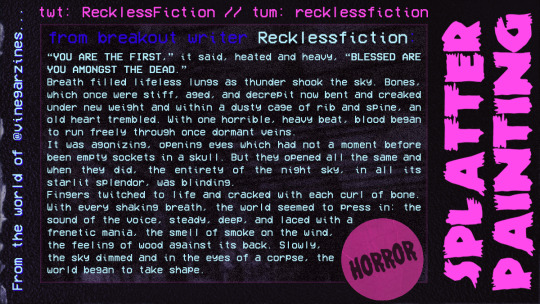
WRITER OF THE DAY - @recklessfiction!
“Breath filled lifeless lungs as thunder shook the sky. Bones, which once were stiff, aged, and decrepit now bent and creaked under new weight and within a dusty cage of rib and spine, an old heart trembled. With one horrible, heavy beat, blood began to run freely through once dormant veins.
It was agonizing, opening eyes which had not a moment before been empty sockets in a skull. But they opened all the same and when they did, the entirety of the night sky, in all its starlit splendor, was blinding.”
24 notes
·
View notes